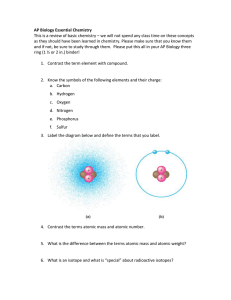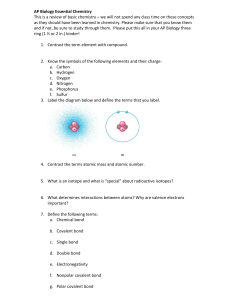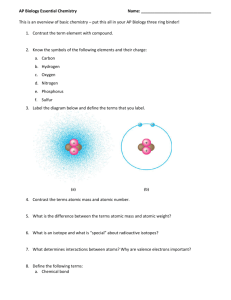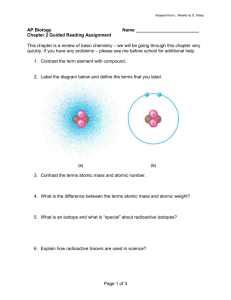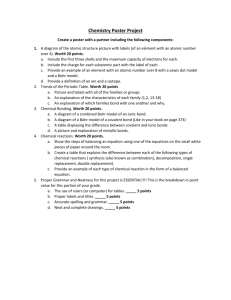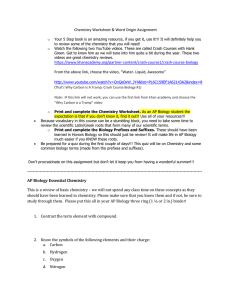AP Biology Summer Assignment
advertisement
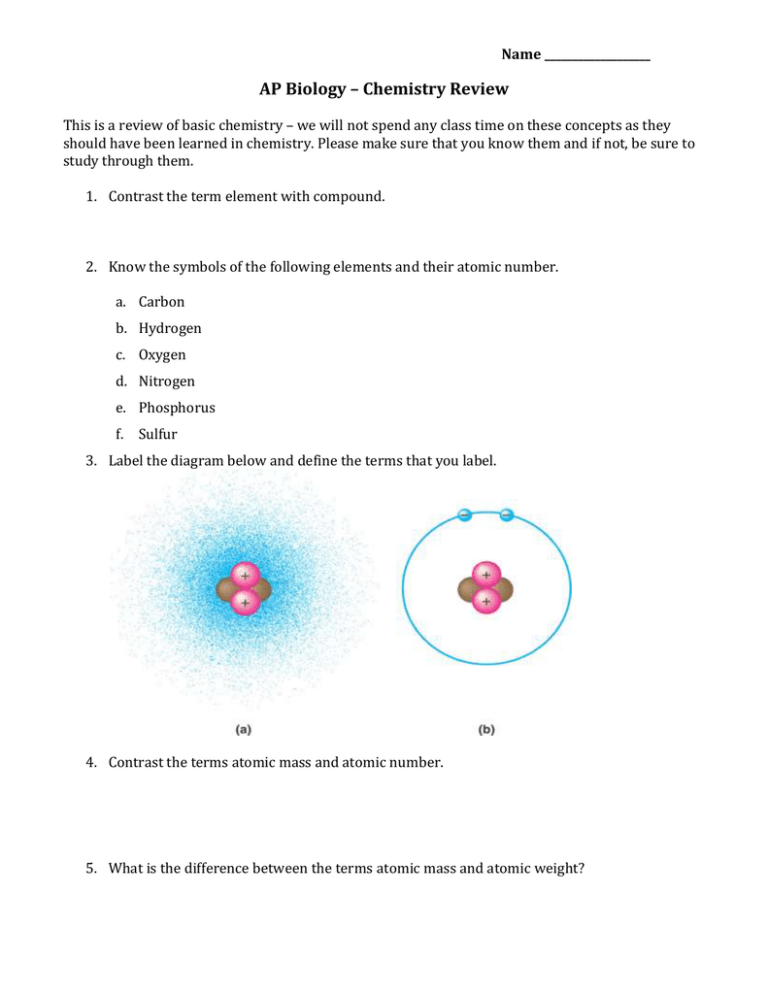
Name ___________________ AP Biology – Chemistry Review This is a review of basic chemistry – we will not spend any class time on these concepts as they should have been learned in chemistry. Please make sure that you know them and if not, be sure to study through them. 1. Contrast the term element with compound. 2. Know the symbols of the following elements and their atomic number. a. Carbon b. Hydrogen c. Oxygen d. Nitrogen e. Phosphorus f. Sulfur 3. Label the diagram below and define the terms that you label. 4. Contrast the terms atomic mass and atomic number. 5. What is the difference between the terms atomic mass and atomic weight? Name ___________________ 6. What is an isotope and what is “special” about radioactive isotopes? 7. What determines interactions between atoms? Why are valence electrons important? 8. Define the following terms: a. Chemical bond – b. Covalent bond – c. Single bond – d. Double bond – e. Electronegativity – f. Nonpolar covalent bond – g. Polar covalent bond – 9. What is the difference between a structural and molecular formula? 10. Know both the molecular and structural formula for the following compounds. a. Oxygen gas b. Carbon dioxide c. Glucose d. Phosphate e. Ammonia f. Water (you would be surprised at how many students miss this!!!) Name ___________________ 11. How do ionic bonds compare with covalent bonds? 12. Compare and contrast hydrogen bonds and van der Waals interactions. 13. Define a dynamic chemical equilibrium in terms of quantities of reactants and products. 14. Why is water considered a polar molecule? 15. For each of the properties of water listed below – briefly define the property and then explain how water’s polar nature and polar covalent bonds contribute to the water special property. a. Cohesion b. Adhesion c. Surface tension d. High specific heat e. Heat of vaporization f. Evaporative cooling Name ___________________ 16. Explain how the properties of water are related to the phenomena described in the statements below. More than one property may be used to explain a given phenomenon. a. During the winter, air temperatures in the northern United States can remain below 0°C for months; however, the fish and other animals living in the lakes survive. b. Many substances—for example, salt (NaCl) and sucrose—dissolve quickly in water. c. When you pour water into a 25-ml graduated cylinder, a meniscus forms at the top of the water column. d. Sweating and the evaporation of sweat from the body surface help reduce a human’s body temperature. e. Water drops that fall on a surface tend to form rounded drops or beads. f. Water drops that fall on your car tend to bead or round up more after you polish (or wax) the car than before you polished it. g. If you touch the edge of a paper towel to a drop of colored water, the water will move up into (or be absorbed by) the towel. 17. What is special about water and density? 18. Define the following terms: a. Solute b. Solvent c. Aqueous solution d. Hydrophilic e. Hydrophobic f. Molarity – 19. MOLARITY Name ___________________ A. Concentration – a. Concentrated – b. Dilute – B. Molarity – a. Symbol – b. Equation – C. Example Problems 1. What is the molarity of a solution formed by mixing 10.0 g of H2SO4 with enough water to make 0.100 L of solution? 2. To prepare 10.5 L of a 2.50 M solution of KOH, how many grams of potassium hydroxide must be used? 3. How many moles of LiBr must be added to .650 L of water to make a 2.0 M solution? 4. What is the molarity of the solution produced when 145 g of NaCl is dissolved in sufficient water to prepare 2.75 L of solution? 5. How many grams of KCl are needed to prepare 0.750 L of a 1.50 M solution? 6. What is the molarity of the solution produced when .594 mol of HCl is dissolved in 0.385 L of water? 7. To produce 3.00 L of a 1.90 M solution of sodium hydroxide, how many grams of NaOH must be dissolved? 8. If 8.77 g of KI are dissolved in enough water to make 4.75 L of solution, what is the molarity of the solution? Name ___________________ 20. Label the diagram below to demonstrate the dissociation of the water molecule and then relate this diagram to the term pH. 21. What defines an acid and a base? 22. Why are small changes in pH so important in biology? 23. What is a buffer? Give an example on how they would work in a living organism. 24. What is acid precipitation and why is it important to living organisms? 25. Why is organic chemistry so important in the study of biology? 26. What is special about carbon that makes it the central atom in the chemistry of life? Name ___________________ 27. Describe and contrast the three types of isomers. Draw a sketch of each a. Structural – b. Geometric – c. Enantiomers – 28. Be familiar with each of the following functional groups – know its chemical compound and the functional properties. a. Hydroxyl b. Carbonyl c. Carboxyl d. Amino e. Sulfhydryl f. Phosphate -
